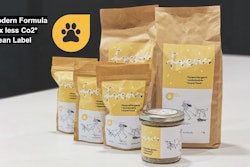
U.S. pet food producers exported an estimated 320,000 metric tons (MT) to Canada, the country’s top trading partner for dog and cat food, in 2019, according to Mallory Gaines, manager of market access & trade policy for the American Feed Industry Association (AFIA). That figure represented a 19.4% increase over 2018’s 268,000 MT of pet food exported to Canada. (She cautioned that 2019 data is not yet final.)
Overall, U.S. pet food exports reached slightly more than 700,000 (projected) in 2019. Other top countries included Japan, Mexico and the Philippines, with New Zealand surging into a strong fifth place, Gaines said. Speaking at AFIA’s 13th Annual Pet Food Conference during the International Production & Processing Expo on January 28 in Atlanta, Georgia, USA, she also provided information on recent and pending U.S. trade agreements that will likely impact pet food.
New US-China trade deal should help pet food
In 2019, the U.S. exported only about 2,400 MT of pet food to China, and that’s just a slight gain over the past four years, when exports totaled less than 2,000 MT per year, according to data presented by Gaines.
The new Phase One trade agreement between the U.S. and China, set to go into effect February 14, may help boost pet food exports. The deal includes provisions sought by AFIA specifically addressing pet food and feed products, including ingredients, Gaines said. For example, the agreement will lift the ban on ruminant ingredients and an accompanying requirement for PCR (polymerase chain reaction) testing of them. Even more germane to pet food, the deal also removes a ban on products with poultry ingredients and rectifies a situation that led to long delays in registering pet food facilities in China.
The elimination or streamlining of processes around such sanitary and phytosanitary (SPS) issues is definitely positive, Gaines explained. “The problem with other countries’ policies is that they weren’t science based,” she added. Yet issues do remain with exporting pet food to China, including tariffs of 29-39% on dog and cat food. In addition, none of the provisions in the Phase One agreement are likely to affect the process for getting pet food products registered in China.
USMCA a positive, more work to do with Japan
A similar situation with Japan over SPS issues is still playing out. While a new deal between it and the U.S. went into effect January 1, 2020, eliminating or reducing 10 of the 12 remaining tariff lines for pet food and feed, Gaines said, a more comprehensive trade agreement is necessary to allow U.S. pet food producers to better compete there.
Thus, though Japan is the U.S.’s second largest market for pet food exports, reaching a projected 56,000 MT in 2019, that number is essentially flat vs. 2018, and both years are a decline from 2017 – and a huge drop from the heyday in 2002 of more than 206,000 MT. Additional factors include that Japan allows in only extruded or retorted pet foods, and no ingredients.
On a more encouraging note, the new U.S. Mexico Canada Trade Agreement (USMCA) signed into law by President Trump on January 29, 2020, provides a long-awaited update to the North American Free Trade Agreement (NAFTA). One positive is that it continues zero tariffs on pet food with both trading partners for the U.S., Gaines said.
Besides the strong exports of pet food to Canada at the top of the U.S. list of trade partners, U.S. pet food producers exported a projected 45,000 MT to Mexico in 2019, making it the third largest export country. That total was up slightly, from 43,000 MT in 2018.
Seeking deals with EU, post-Brexit UK
In the European Union (EU) the U.S. exports pet food to several countries, with Germany, the Netherlands, Belgium and the U.K. counting as top markets; yet only the Netherlands receives more than 12,000 MT of U.S. pet food, with the others registering only 4,000-6,000 MT. At play are several SPS issues, geographical factors and tariffs of 3.8-9.6%, depending on the pet food category.
With the official start of Brexit on January 31, 2020, and now an 11-month transition period, the U.S. has a chance to strike new trade deals with both the U.K. and the EU, Gaines said. Regarding the latter, “they seem much more eager to negotiate, as do we; it’s a big opportunity,” she added.

















